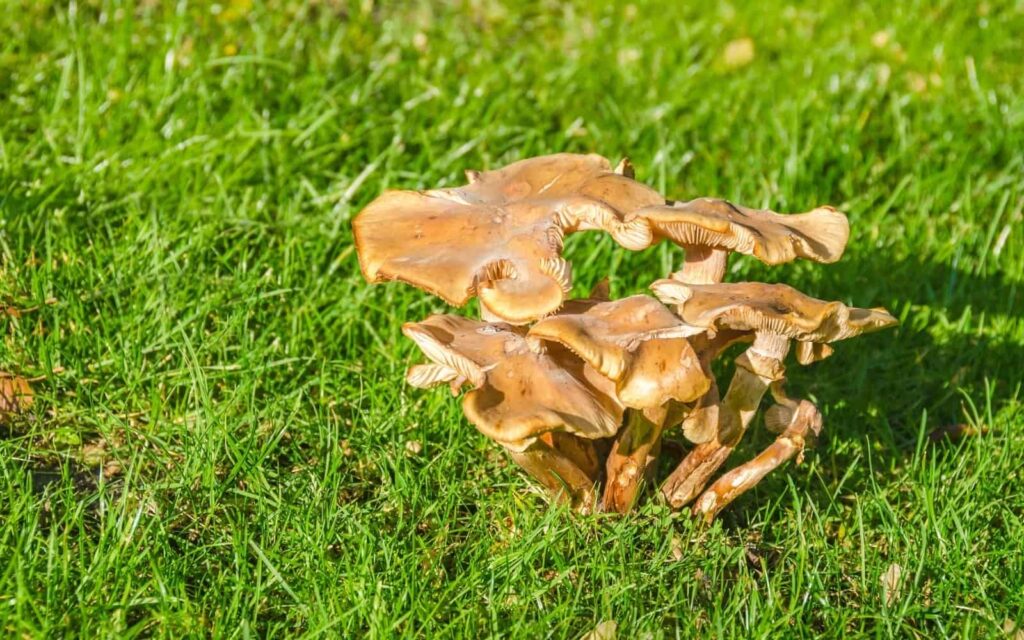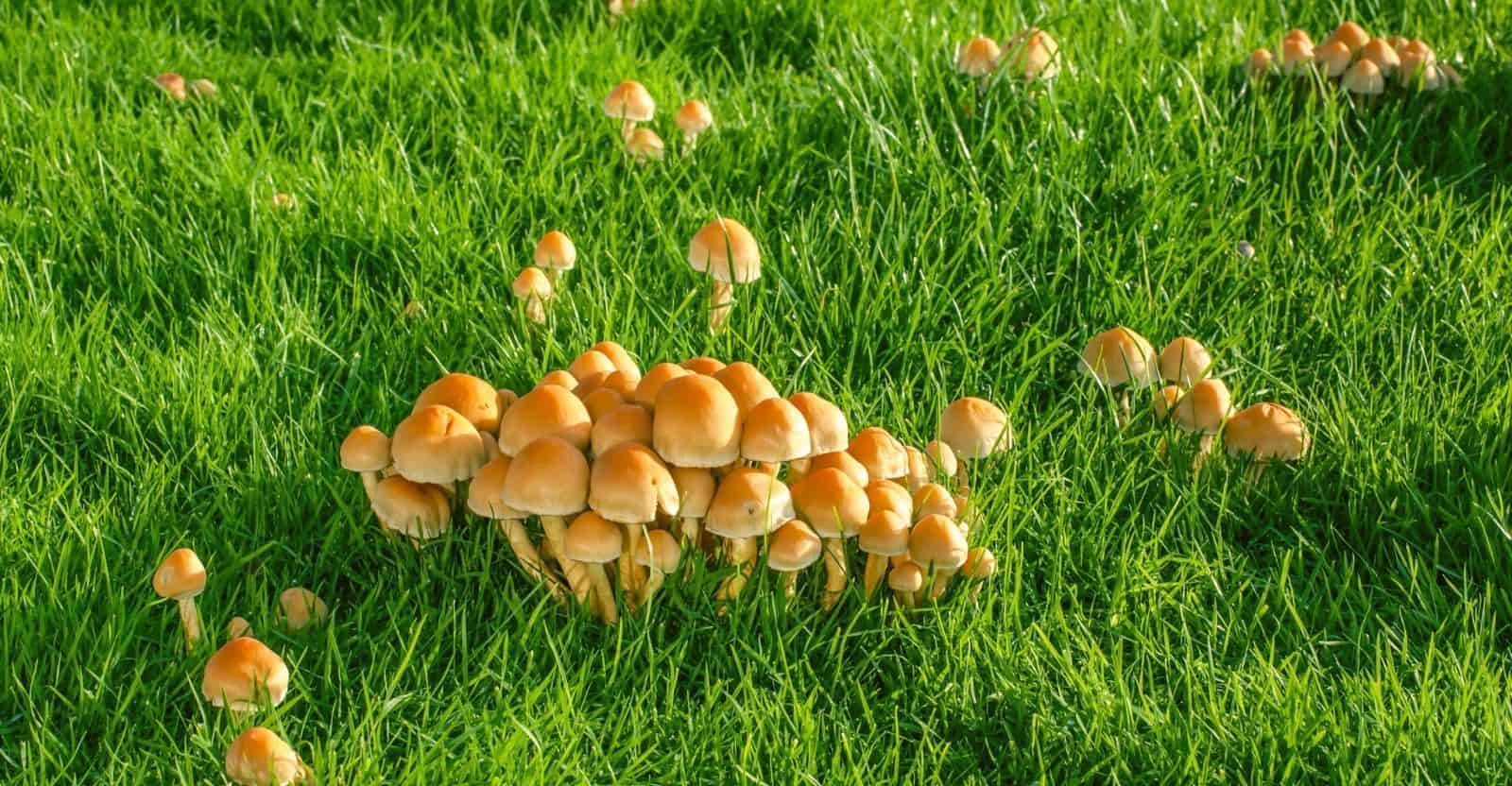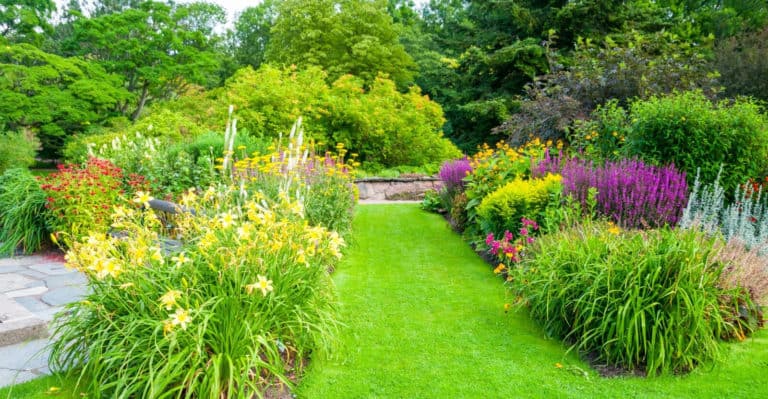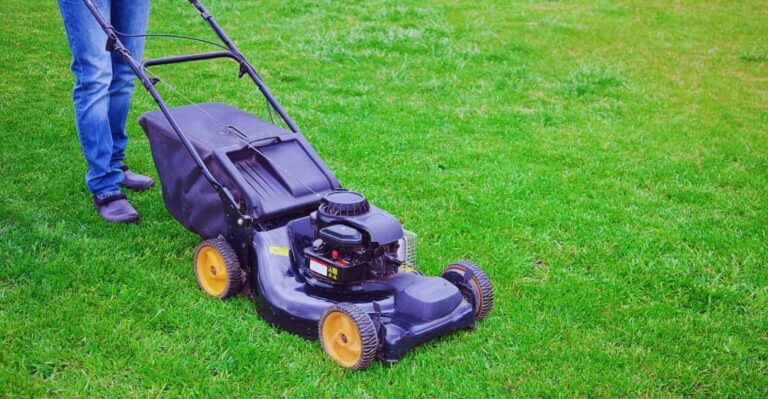Amazon has put together some great Home Gift Deals – save money and get your shopping done at the comfort of your home! Click here to see deals on Amazon
If you have a healthy lawn and have noticed varieties of mushrooms growing on it, you may be interested in knowing that these mushrooms are perennial and can be tough to control.
There are many ways to get rid of unwanted mushrooms on your lawn. The internet is full of articles on “How to get rid of mushrooms in the yard.” Some reports recommend people to use commercial fungicides, while other experts recommend mulching the area to prevent spores from germinating and sprouting.
You have to weigh the pros and cons to determine what’s the best for your lawn care needs. So here are several ways you can kill mushrooms from your lawn and prevent it from coming back.
What causes mushrooms to grow on a lawn?
Mushrooms are a type of fungus that thrives in a damp, dark environment and feed on decaying matter. There are different shapes and sizes of mushrooms growing on a lawn. Some are toadstool type, while some have stems with a cap and gill underneath them.
Often people think the mushroom they buy from the market to eat is the same mushroom growing on the lawn. Although most mushroom species growing in the yard aren’t toxic, you shouldn’t eat them.
Fortunately, you won’t see mushrooms growing up on the lawn year-round. They’re most visible when they find suitable conditions to grow but the fungi responsible for growing mushroom remains in the soil year-round.
These beneficial fungi feed on the decaying organic matter and help convert fallen leaves, dead tree roots, and pruned tree trunks into nutrients necessary for the growth of plants.
Growing mushrooms on the lawn is a sign that you have healthy soil. These types of fungi have long, twisted root-like structures that are known as Hyphae.
The hyphae help break down organic matters into essential nutrients that benefit plant growth. The mushroom fungus spreads through microscopic spores either through natural winds, sticking to pets’ fur, or naturally creates wind by allowing moisture to evaporate and spread around.
The spores can spread several feet around, increasing the number of mushrooms growing on the lawn. Also, these fungi feed on the decaying organic material in the soil. If you use organic compost or have dog or cat animal waste left in the yard, the fungus thrives on these and continues to spread further.

What are the most common mushrooms you can find on lawns?
There are over 1,000 different species of mushrooms in the world, and they’re found in almost everything. Very few are poisonous, while others are edible. The following are the most common species found on the lawn.
Honey Fungus (Armillaria mellea): These are found in clusters that grow up to 15 cm high and 2 cm wide. You can find them growing under large trees in the spring. These have yellow-brown color crowns.
Meadow Mushroom (Agaricus campestris): This mushroom looks similar to mushrooms bought from stores for eating. It grows aggressively after rainfall in the grassy areas. These can often be found in small clusters and grow caps up to 12 cm tall and 2 cm in diameter.
Turkey Tail Mushroom (Trametes versicolor): The mushroom has a white to brownish crown and is made of very densely packed pores. The mushroom cluster appears to be like a turkey tail with a small to a mid-sized cap.
Orange Peel Mushroom (Aleuria aurantia): It’s a common fungus of the soil and wood. Most often, you find it growing around ornamental trees, bushes, and perennials. This species is the most commonly found in lawns.
False Parasol (Agaricus campestris): This white mushroom isn’t a parasol. Its members of the Agaricus genus resemble a chubby mushroom cap with a tiny stalk. The brown patch on the cap develops into scales. It grows most around the decaying woods, dead grass clippings, and other organic matters.
Green-Spored Lepiota (Chlorophyllum molybdites): These mushroom varieties are commonly found when the weather starts to get colder. It grows on the ground where there is a lot of grass and dirt. It’s a dark-colored mushroom that changes color depending on its growing condition.
Shaggy Ink Cap (Coprinus): This is another most commonly found mushroom in the lawns and gardens. It’s from a member of the genus Coprinus that grows in the soil. The cap is initially convex-shaped before drying. It then turns flat dark brown with stains of purple or yellow.
Stinkhorn Fungus (Phallus impudicus): This is a very strong-smelling fungus that grows on the tree bark, decaying wood, or in the ground in damp areas like lawns and forest floors. They’re commonly found in yards, especially in the fall when the surface soil dries out.
Note:
Although it’s not very common to find a poisonous mushroom growing on the lawn, you should watch if you have kids or pets playing in the yard not to let them eat an unknown mushroom.

How to get rid of mushrooms in the yard naturally?
Mushrooms are known to be an invasive species that can quickly take over your lawn or garden. They start small under the soil surface and then just keep growing. While they’re not harmful to humans, they can be a nightmare for homeowners who want a beautiful yard.
If you have a yard full of mushrooms, it might be time to try some natural ways to get rid of them. Here are some easy solutions that anyone can take.
1. Stop the spores from a spread
Mushroom fungi spread through spores. When you have mushrooms growing on your lawn, you should always wash your clothes and shoes after walking through a patch of mushrooms or touching them with your hands.
If you have pets playing in the mushroom growing yard, you should give them a quick wash to reduce the spread.
2. Keep the yard free from dirt
Organic decaying matters such as pet waste, rotting wood, and leaves are the food source for mushroom fungi. Your yard should be clean from dead clippings, leaves, and organic waste. It prevents mushrooms from taking over your lawn areas as these micro-organisms can’t survive in a clean environment.
When mowing your lawn, leave only a little fine-chopped grass in the yard. Also, consider bagging or raking organic materials, but keep it light and infrequent, so you don’t remove precious nutrients from the soil.
Rake fallen leaves from the lawn in the fall. Make sure to keep your garden de-thatched and remove the old tree stump as they invite mushrooms to grow.
If you have recently removed trees and shrubs but haven’t removed stumps or roots under the ground, these are likely to decompose below the soil and encourage fungal growth.
3. Aerate your lawn
Regularly aerating your lawn, at least once a season, keeps your lawn healthy. It allows the water and nutrients to move inside the soil rather than sitting above the grass surface. The aeration helps break the hyphae cluster from the ground, which reduces the mushroom spread.
Before aerating your lawn, ensure you remove mushrooms; otherwise, you could spread the spores further, making the problem worse. Also, keep the lawn grass to be at short to medium height. The shorter grass allows more sunlight and air to pass to the soil while it dries quickly, reducing moisture in the ground.
4. Have a good drainage
For most lawns, the fungus is always present in the soil that can grow on its own. You only see the mushrooms when the ground conditions become highly favorable.
Having good drainage is essential for any lawn. It also helps reduce the root rot in the smaller plants and flowers, reducing the soil’s waterborne diseases.
Appropriate drainage allows the excess water such as from rain or irrigation to move away from the grass. It reduces the soil compaction that helps with plant growth and reduces hyphae cluster formation.
You can identify lawn drainage problems if you see sporadic muddy patches and small patches of water pooling in the lawn. Sometimes you have to flat the ground and regrade the yard to fix any draining issue.

5. Bring in more sunlight
The less amount of sunlight your lawn receives determines how well mushrooms will grow there. The damp and dark environment is highly conducive to the growth of mushrooms. Having too much shade in your lawn spurs their growth.
It’s often larger trees with spread-out branches that obstruct the sunlight from reaching the ground. You should prune these long and shady branches. Sunlight keeps the ground bit dry, which kills the fungus growing mushrooms.
6. Water deep but infrequent
Yard plants and grass need water, but you should water your lawn sparingly. Reducing the interval to every 3–4 days makes your grass less wet, reducing the growth condition of mushrooms.
You should change your lawn water schedule to be early morning to allow the water to get dry during the day and lower the excess moisture level in the soil. Avoid overwatering your lawn as that dampens the ground, which encourages mushroom growth.
7. Use nitrogen fertilizer
A nitrogen deficiency in lawn encourages mushroom growth. Adding nitrogen-rich fertilizer increases the speed of decay of the organic matter that mushroom fungi feed. The faster the decay happens, the quicker the life cycle of mushrooms ends.
This goes in hand with keeping the lawn clean and free from decaying organic debris. Application of 5 pounds ammonium sulfate per 1,000 square feet is a good practice.
How to kill mushrooms in the yard (aggressive treatment)?
If you don’t take precautions when mushroom fungus grows in your backyard, you could lose your entire garden. It can take weeks of waiting for them to go away on their own, or you can use the following strategies to kill mushrooms in your yard.
8. Physically pull mushroom
For a small number of mushrooms on the lawn, you can remove it easily by hand, cutting the mushroom head with a knife, or running over the entire area with the lawnmower.
You have to be proactive and remove them as soon as you see them. If you let mushroom mature, it releases spores and grow new mushrooms.
You have to be careful not to spread the mushroom spores while removing them physically. The spores get transferred by wind, bugs, or pet animals. Check the ground surface before mowing and remove any visible mushrooms to stop the spores spread.
9. Use Dish detergent
No one ever thinks of using their dish detergent to kill mushrooms, but it’s a simple solution that works. You can mix some dish detergent in a cup of water and sprinkle it on the affected areas of the lawn.
The detergent will kill the fungus and prevent it from spreading to your other plants. You can poke holes in the soil around the mushroom and pour soapy water over and into these holes, interrupting the fungus life cycle.
Do this for a week, and you will see some results in reducing mushroom growth, and you will feel proud of your beautiful lawn.

10. Kill Mushrooms with vinegar
Vinegar is very effective in killing weeds, including mushrooms. It’s a homemade organic solution that will kill the fungus without using any harmful chemicals. Now, of course, this isn’t a hard-and-fast method, but it’s a reliable one that works best on young mushrooms.
You should be using high concentration vinegar rather than the diluted vinegar available for consumption. You have to be careful using vinegar and not spray it on surrounding plants and green lawn grass that you want to keep.
You can make homemade fungicide by adding five tablespoons of vinegar into a gallon of water and filling the solution in a spray bottle.
You should use a knife or pruner to cut grown mushrooms and store it in a plastic bag to prevent spores from spreading. Then spray the vinegar solution where the mushroom had grown.
11. Use baking soda to kill mushroom
There is no doubt that when it comes to killing mushrooms, it’s best to use a natural product, as any chemical or anti-fungal product can cause issues. In reality, baking soda isn’t a fungicide, but it helps control mushroom growth indirectly.
Applying baking soda (Amazon link) in the soil changes the ground pH level that inhibits the mushroom growth. It’s certainly not a very practical solution if your lawn is heavily infested with mushrooms. Still, for small mushroom numbers, it works.
To make this organic herbicide, add two tablespoons of baking soda for each gallon of water and stir until it’s fully dissolved. You can then spray the mixture onto the mushroom and adjacent areas.
12. Use fungicide
Fungicide is the last resort but is very effective in controlling mushroom growth. Fortunately, there are several different types of fungicide available to purchase that you can spray on your lawn. We found Grower’s Alley fungicide (Amazon link) to be highly effective in killing mushrooms.
You can spray fungicides on the lawn or directly on the mushroom. In reality, fungicide doesn’t kill the mushrooms, but it keeps the mushrooms from growing. However, most lawn fungicides are designed for leaf mold or root rots but are equally effective on mushrooms.
You have to make sure that it should penetrate deep in the soil to reach hyphae when spraying fungicide. Without killing hyphae, there is always the risk of mushrooms growing again. Like any other herbicide, you should exercise caution and not let children or pets play on the lawn for a few days.
The best time to apply herbicide depends on the area and the severity of mushroom growth. Once the fungus is dead, you can use a shovel to dig it out of the yard.
13. Dig it up
For most people, all the above strategies should work to get rid of mushrooms. But if you have very unhealthy soil conditions with organic matters decaying inside the soil, and no amount of fungicide seems to treat the problem, you have to use this as a last option.
You should remove the top 14–15-inch layer of soil and up to 18 inches outside the affected area. It’s vital to remove a few inches more than the visible mushroom area to eliminate all the hyphae spread underneath the surface.
Be careful not to spread the removed soil to the other areas of the lawn. Store it in a plastic bag and dispose of it safely. You can then fill the space with fresh soil and spread some grass seed to cover the patch.
How to stop mushrooms from growing in the grass and make it pet safe?
There are several ways to stop mushrooms from growing on your lawn. First of all, you must understand that it needs a suitable environment to thrive. So, if you want to get rid of them, you must make sure they don’t have a favorable growing environment.
You can drastically reduce mushroom growth in the grass by not overwatering the lawn and keeping it free from fallen leaves and decaying organic matter. If you have dogs or cats, make sure not to let their poop rot on the lawn.
Prune any large tree branch to reduce shade on the lawn. Treat it with fungicide for any localized fungi growth in the grass or compost pile and pull it out from the ground.
Be careful when removing it physically not to let spores spread. Dig out at least 15–20 inches deep into the soil and around affected areas to remove all the hyphae under the surface.
Although there are very few toxic lawn mushrooms, they could upset the stomach if eaten by pets such as dogs or cats. To keep your lawn free from the mushroom and safe for your pet, you can spray vinegar mixed with water on the mushroom.
Conclusion
There you have it, several different strategies to get rid of mushrooms growing in your lawn and prevent them from returning. We have pointed out several effective ways to get rid of the fungus, but whether or not you’re successful will depend on the extent of the problem and underlying soil condition.
We suggest that you experiment with different methods until you find the one that works best for your lawn.

Don’t forget to share this post







